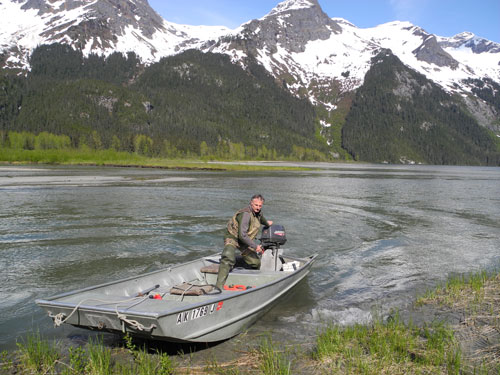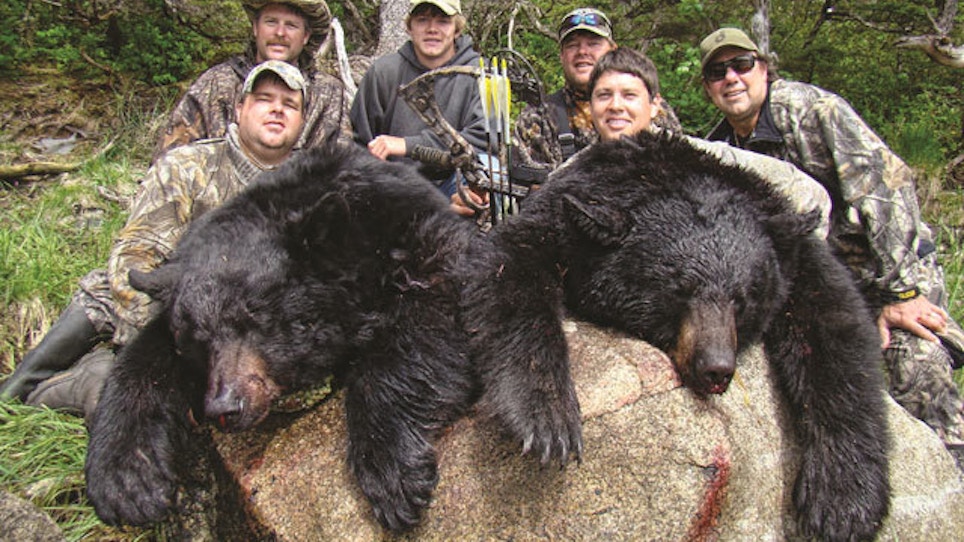A black bear hunt is as much fun as a hunter can have. The anticipation of hunting something dangerous in breathtakingly beautiful country—plus good odds of taking a decent bear—make it one of the best hunts for the money.
Fall Bear Hunts
Fall hunts are great, especially if you can combine it with another species. Alaskan black bear hunting doesn’t require a guide, so combining it with a caribou or moose hunt is ideal.
In the Lower 48, black bears range from northern Maine to southern California. Most states have bear hunts; some even offer over-the-counter archery tags. Most of these are quote hunts, however. Once the quota is filled, the hunt is closed.
Many states offer a draw application for tag draws each spring. If you go this route, apply early, get the proper license, fill the paperwork out correctly, and send it in before the deadline.
Spring Bear Hunts
 If bowhunting a black bear and only black bear is your priority, I recommend a spring hunt, especially in Alaska. Alaska’s numerous black bears can be found just about everywhere (except Kodiak Island) with the biggest concentrations in south central and southeastern Alaska. Some areas or units have such large bear populations that hunters can take more than one.
If bowhunting a black bear and only black bear is your priority, I recommend a spring hunt, especially in Alaska. Alaska’s numerous black bears can be found just about everywhere (except Kodiak Island) with the biggest concentrations in south central and southeastern Alaska. Some areas or units have such large bear populations that hunters can take more than one.
Bear Hunting Methods
For something different, try hunting with dogs. Check state regulations and see what they have to offer. Like cougar hunts, dogs pick up the trail and tree the bear. Bowhunters need to be in decent shape and able to get from Point A to Point B quickly.
Where legal, the most popular hunting method is over bait. Baiting bears does require the hunter to register, get a permit, and, in some GMUs, attend a clinic. Finding a location, suitable tree for a stand, and proper bait placement (after a bit of scouting) are the keys to success. When scouting, most hunters cruise rivers or drive roads to spot a bear or two before deciding on station placement. Many hunters use the same locale each year successfully.
Spot & stalk works great, especially with access to a boat or a raft. Being able to cruise a shoreline’s many beaches, coves, and inlet flats where black bears feed is not just rewarding, but exciting. Spotting bear from your skiff, then getting to the beach for a stalk can be a challenge. Bowhunters must be patient, super-quiet, and watch the wind. Let things unfold slowly while either you work toward the bear or let the bear come to you.
DIY vs. Guided Hunts
Bowhunters can book DIY hunts pretty easily. Many lodges, particularly in southeast Alaska, offer packages with access to a cabin, boat, and ATV. These DIY-type hunts are cheap, and the success rate is usually high. Book early and try to get in a couple days of scouting if possible.
Or, hire a guide. (For non-residents this may be your only choice.) Yes, it’s more expensive, but a guide has big advantages. He brings gear and expertise. He has already done the scouting, set the baits, has the proper permits, and will take care of you during the hunt.
Last, but not least, is the option of bowhunting from a boat, usually a large fishing vessel or sport fishing rig that can handle the Alaskan weather. It’s a blast, especially if you book it as a group. These hunts are usually unguided, but the outfitter provides all the comforts of home. Most hunts are five to six days, depending on weather. Twice a day you board a skiff and hunt the prime time hours looking for your bear. Non-hunting hours are spent fishing or just relaxing.






